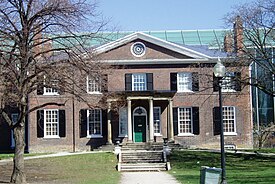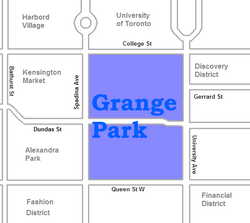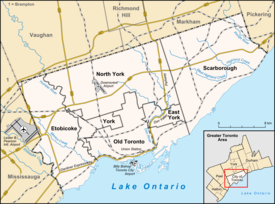Grange Park (neighbourhood)
| Grange Park | |
|---|---|
| Neighbourhood | |

The Grange, from which the area gets its name.
|
|
 |
|
| Location within Toronto | |
| Coordinates: 43°39′11″N 79°23′35″W / 43.653°N 79.393°WCoordinates: 43°39′11″N 79°23′35″W / 43.653°N 79.393°W | |
| Country |
|
| Province |
|
| City |
|
| Government | |
| • MP | Adam Vaughan (Trinity—Spadina) |
| • MPP | Han Dong (Trinity—Spadina) |
| • Councillor | Ceta Ramkhalawansingh (Ward 20 Trinity—Spadina) |
Grange Park is a neighbourhood in downtown Toronto, Ontario, Canada. It is bounded on the west by Spadina Avenue, on the north by College Street, on the east by University Avenue and on the south by Queen Street West. It is within the 'Kensington-Chinatown' City of Toronto planning neighbourhood. Its name is derived from the Grange Park public park. The commercial businesses of Chinatown extend to within this neighbourhood.
Grange Park was initially an elite neighbourhood, with mansions lining Beverley Street. The neighbourhood took its name from The Grange, a mansion built in 1817 by D'Arcy Boulton, Auditor-General of Upper Canada and a member of the prominent Boulton family. The Grange is the oldest standing brick house in Toronto. It served as the first home of OCAD University, and today forms a wing of the Art Gallery of Ontario. Prominent early residents of the neighbourhood included George Brown, a Father of Confederation and founder of The Globe newspaper (186 Beverley Street) and the family of William Lyon Mackenzie King, Canada's longest serving Prime Minister (147 Beverley Street).
The area was transformed into a working class, immigrant community by 1900 with rows of workers' cottages. Many of the more prominent brick row houses, built in the Edwardian style, still survive in the neighbourhood today. By 1914, the area had become predominantly Jewish as Eastern European Jewish immigrants left The Ward and moved west of University Avenue towards Spadina Avenue. Synagogues and other community institutions were located on McCaul, Beverley and Cecil streets. Among the more famous Jewish residents was the family of architect Frank Gehry, whose grandparents owned a rowhouse at 15 Beverley Street. Gehry later recalled that his first exposure to art came at the Art Gallery of Ontario, for which he was later commissioned to design renovation completed in 2008.
...
Wikipedia

